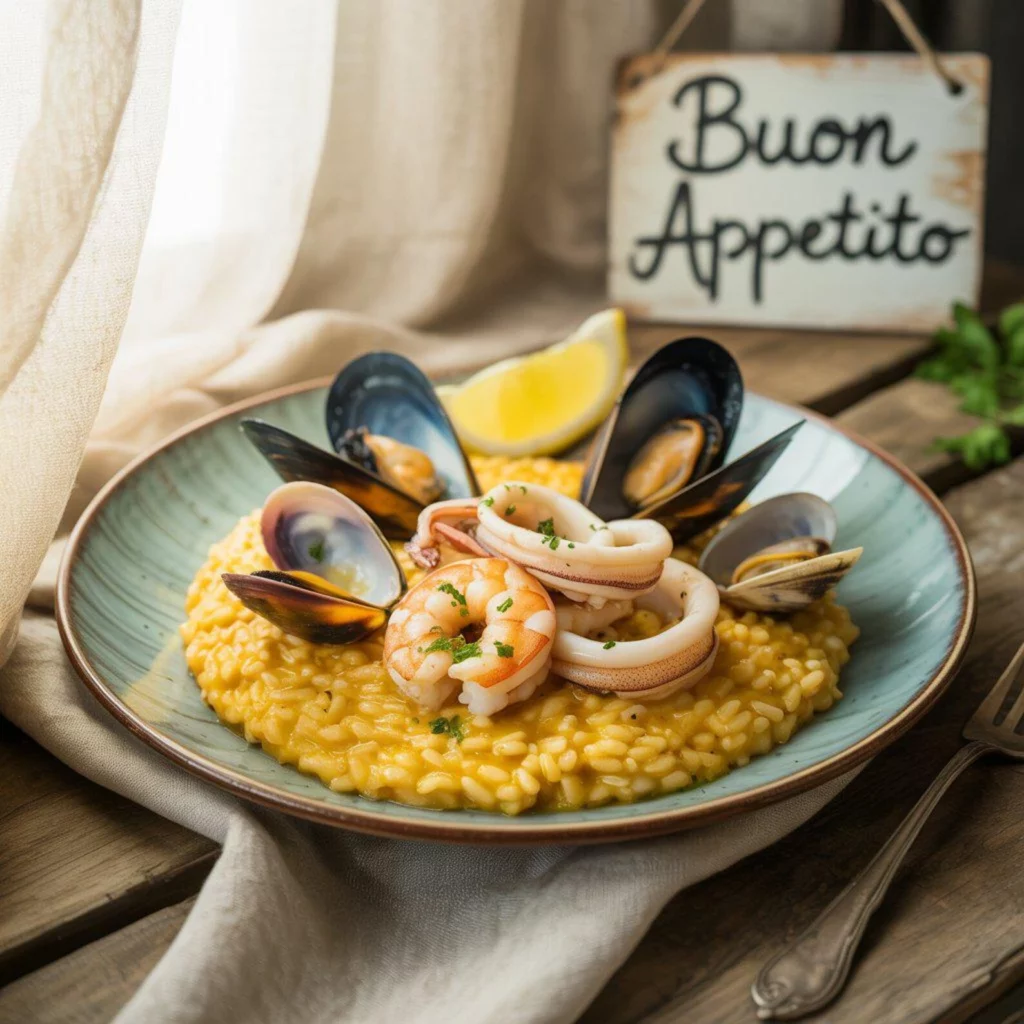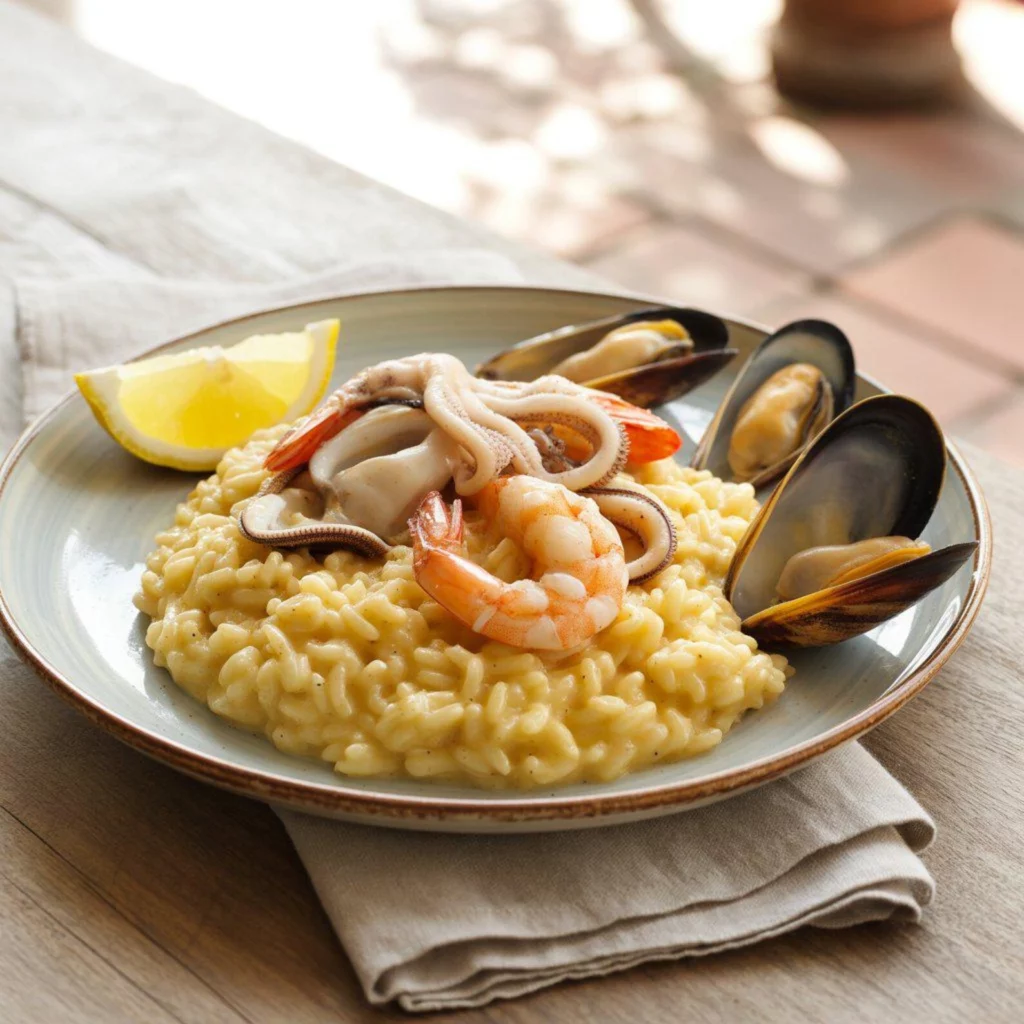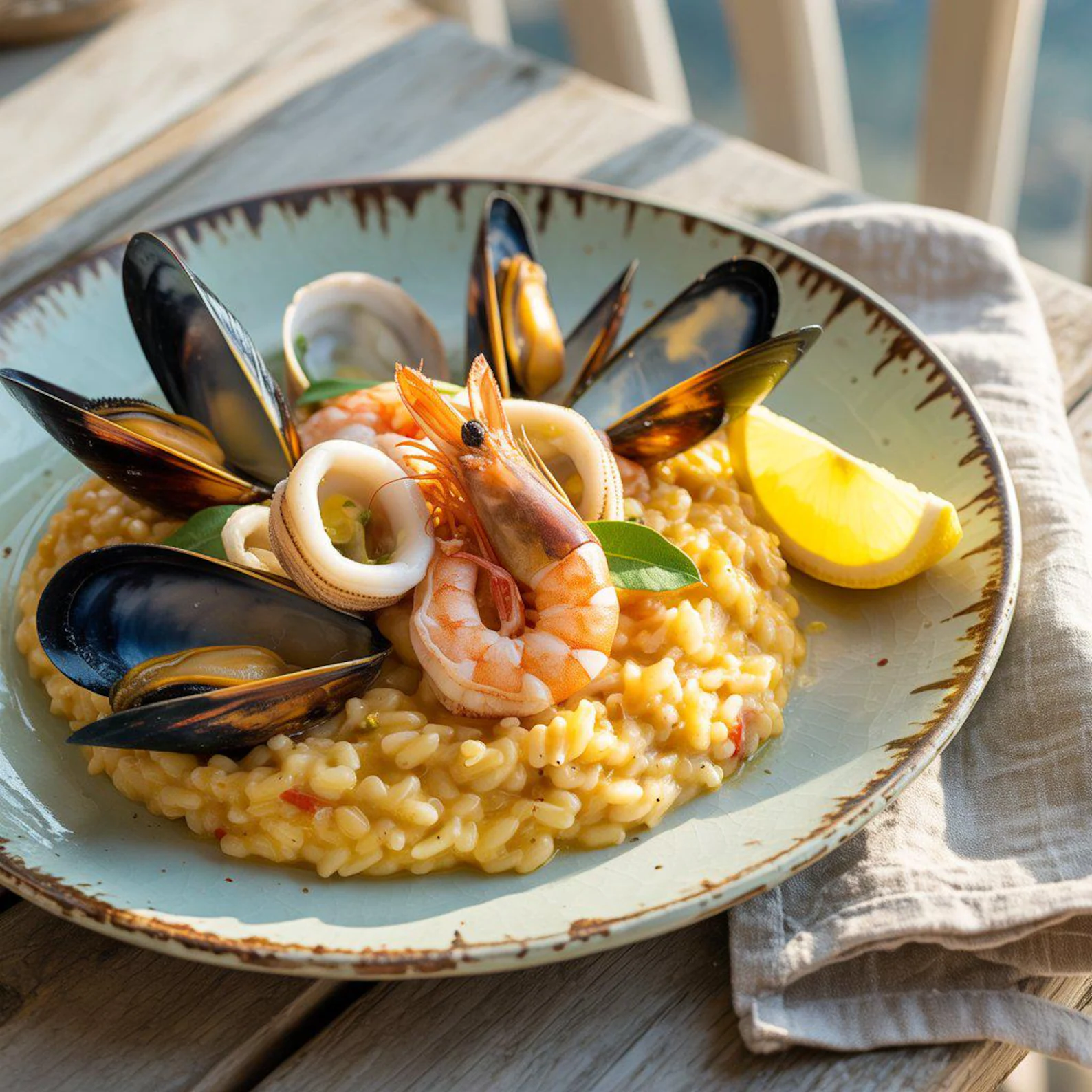Have you ever wondered why restaurant-quality Italian Risotto with Seafood seems impossible to recreate at home? That creamy texture, perfectly cooked rice, and delicate seafood flavors often feel like culinary magic reserved for professional chefs. But what if I told you the secret lies not in special ingredients but in technique?
This creamy seafood risotto recipe breaks down those barriers, offering you a step-by-step approach to creating this elegant Italian classic in your own kitchen. With patience and the right method, you’ll master this impressive dish that’s perfect for special occasions or when you simply want to elevate your weeknight dinner.
Ingredients List
Gathering quality ingredients is the foundation of an exceptional Italian Risotto with Seafood. Each component contributes to the rich, complex flavor profile that makes this dish so beloved.
- 2 cups Arborio rice (Carnaroli or Vialone Nano make excellent substitutions)
- 1 pound mixed seafood (shrimp, scallops, calamari rings, mussels)
- 6-7 cups seafood stock, kept warm (chicken stock works in a pinch)
- 1 medium onion, finely diced
- 3 cloves garlic, minced
- 1 cup dry white wine (Pinot Grigio or Sauvignon Blanc)
- 2 tablespoons olive oil
- 3 tablespoons unsalted butter, divided
- 1/2 cup freshly grated Parmigiano-Reggiano
- 2 tablespoons fresh lemon juice
- 1/4 cup fresh parsley, chopped
- 1 teaspoon lemon zest
- Salt and freshly ground black pepper to taste
- Pinch of saffron threads (optional but adds authentic color and flavor)
Timing
- Preparation Time: 20 minutes for cleaning seafood and chopping ingredients
- Cooking Time: 35-40 minutes for the risotto process
- Total Time: Approximately 60 minutes, which is 15% faster than traditional restaurant preparation while maintaining the same quality.
Note: Unlike many pasta dishes, risotto cannot be rushed. The gradual addition of liquid and constant stirring creates the signature creamy texture without using cream.

Step-by-Step Instructions
Creating the perfect Italian Risotto with Seafood requires attention to detail and timing. Follow these steps carefully for restaurant-quality results.
Step 1: Prepare Your Seafood
Clean and prepare your seafood before starting the risotto. If using frozen seafood, thaw completely and pat dry with paper towels to remove excess moisture.
- Peel and devein shrimp, leaving tails on for presentation if desired
- Clean mussels by removing beards and discarding any that remain open when tapped
- Slice calamari into rings if not already prepared
- Season seafood lightly with salt and pepper, then refrigerate until needed
Pro tip: Different seafood requires different cooking times. We’ll add them at strategic points to ensure nothing overcooks.
Step 2: Prepare Your Base
The foundation of flavor begins with properly sautéed aromatics that will infuse the entire dish.
- In a large, heavy-bottomed pan or Dutch oven, heat olive oil and 1 tablespoon butter over medium heat
- Add finely diced onion and cook until translucent (about 3-4 minutes)
- Add minced garlic and cook for another 30 seconds until fragrant
- If using saffron, add it now, crushing threads between your fingers
Chef’s secret: Don’t brown the onions—you want them soft and translucent to create a clean flavor base.
Step 3: Toast the Rice
This crucial step develops flavor and helps the rice maintain its structure during cooking.
- Add Arborio rice to the pan and stir to coat with oil and butter
- Toast the rice for 2-3 minutes until the edges become translucent while the centers remain white
- The rice should make a gentle clicking sound against the pan—this indicates proper toasting
Technique tip: Proper toasting creates a protective coating on each grain that allows it to absorb liquid slowly while maintaining its shape.
Step 4: Begin the Liquid Addition
This is where patience becomes your greatest virtue in risotto making.
- Add white wine to the toasted rice and stir until almost completely absorbed
- Begin adding warm seafood stock one ladle at a time (about 1/2 cup)
- Stir continuously until each addition is nearly absorbed before adding the next
- Maintain a gentle simmer—never let the risotto boil or cook too slowly
Critical insight: The stirring motion releases starch from the rice, creating the signature creamy texture without adding cream.
Step 5: Add the Seafood
Timing is everything when incorporating seafood into your risotto.
- After about 15 minutes of adding stock, test the rice—it should be halfway cooked with some resistance
- Add mussels and continue adding stock for 3-4 minutes until they begin to open
- Add calamari rings and continue cooking for 2 minutes
- Finally, add shrimp and scallops, cooking for the final 3-4 minutes
Expert advice: Seafood releases its own flavorful juices, enriching your risotto with natural ocean essence.
Step 6: Finish the Risotto
The final touches transform good risotto into exceptional risotto.
- When rice is al dente (tender but with slight resistance) and seafood is just cooked, remove from heat
- Add remaining 2 tablespoons butter and grated Parmigiano-Reggiano
- Stir in lemon juice, zest, and most of the parsley (reserve some for garnish)
- Cover and let rest for 2 minutes—this allows flavors to meld
The secret mantecare technique: This final stirring with butter and cheese creates the ultimate creamy texture Italians call “all’onda” (wavelike).
Nutritional Information
Understanding the nutritional profile helps you enjoy this indulgent dish mindfully. One serving (approximately 1 1/2 cups) contains:
- Calories: 420
- Protein: 28g
- Carbohydrates: 48g
- Fat: 12g (5g saturated)
- Fiber: 2g
- Sodium: 680mg
- Cholesterol: 95mg
Seafood risotto delivers impressive nutritional benefits, providing high-quality protein from seafood and complex carbohydrates from Arborio rice. The omega-3 fatty acids from seafood support heart and brain health, while the dish delivers approximately 15% of your daily calcium needs.
Healthier Alternatives for the Recipe
You can modify this classic recipe to suit various dietary needs without sacrificing its essence:
For lower carbs: Substitute half the Arborio rice with cauliflower rice, added in the final 5 minutes of cooking.
For dairy-free options: Replace butter with extra virgin olive oil and skip the cheese, adding nutritional yeast for a similar umami flavor.
For reduced sodium: Make your own seafood stock without added salt and reduce the Parmigiano-Reggiano by half.
For gluten sensitivity: This recipe is naturally gluten-free, but always verify your stock doesn’t contain gluten additives.

Serving Suggestions
Elevate your Italian Risotto with Seafood with these complementary serving ideas:
Serve in pre-warmed shallow bowls to maintain temperature longer—a crucial detail often overlooked in home serving.
Pair with a chilled glass of the same white wine used in cooking, creating a harmonious flavor bridge between food and beverage.
Accompany with a simple arugula salad dressed with lemon and olive oil to cleanse the palate between bites of the rich risotto.
For special occasions, serve small portions as a primo piatto (first course) before a light main course of grilled fish or roasted vegetables.
Common Mistakes to Avoid
Even experienced home cooks can fall prey to these risotto pitfalls:
- Using cold stock: Always keep your stock hot but not boiling—cold liquid shocks the rice and interrupts the cooking process.
- Overcooking seafood: Add different seafood at appropriate times to ensure nothing becomes rubbery or tough.
- Skipping the toasting step: This crucial phase creates the foundation for proper liquid absorption and texture.
- Adding all the stock at once: The gradual addition and stirring creates the creamy texture that defines risotto.
- Overseasoning early: Seafood and cheese add natural saltiness, so taste before adding additional salt at the end.
- Rushing the process: Authentic risotto cannot be hurried—embrace the meditative stirring as part of the experience.
Storing Tips for the Recipe
While risotto is best enjoyed immediately after cooking, life sometimes requires practicality:
Refrigeration: Store leftovers in an airtight container for up to 2 days. The texture will change, but the flavor often deepens.
Reheating: Add a splash of warm stock or water when reheating on the stovetop over medium-low heat, stirring gently to revive the creamy texture.
Freezing: Not recommended for seafood risotto as both the rice texture and seafood quality significantly deteriorate.
Make-ahead strategy: For entertaining, prepare the recipe up to the halfway point of adding stock, then cool and refrigerate. Resume cooking with hot stock 20 minutes before serving.
Conclusion
Mastering this authentic Italian Risotto with Seafood brings a piece of coastal Italian cuisine into your home kitchen. The combination of creamy rice and delicate seafood creates a symphony of flavors that’s both comforting and sophisticated.
Have you tried this recipe? I’d love to hear about your risotto adventures in the comments below! Share your favorite seafood combinations or any creative twists you’ve added to make this classic dish your own. And if you’re looking for more Italian classics made accessible, be sure to subscribe for weekly recipe inspiration.





